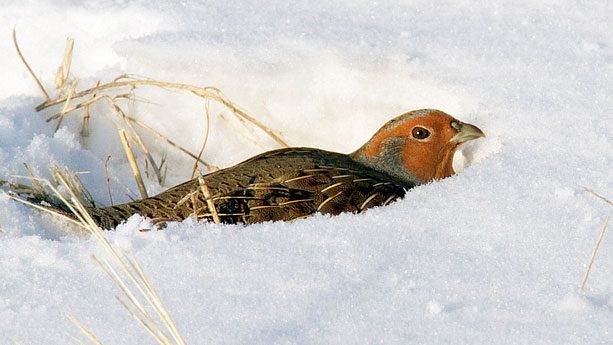Do partridges occur in pear trees?

Around this time of year we do receive a spike in sightings of partridges in pear trees, although curiously there never seems to be more than one individual reported per pear tree.
Both partridges and pear trees are Old World species that have been introduced into North America, which means that the story could have originated in any of a number of places. We checked the scientific literature to see what we could dig up.
There are 15 genera of partridges in the world, comprising nearly 50 species (check the Birds of the World taxonomy browser for the full tally). Two of these, the Chukar and the Gray Partridge, have established populations in North America, particularly in the Intermountain West and Great Plains.
According to Birds of the World, Gray Partridges roost and forage mostly on the ground. In winter they typically roost in the snow, but they do sometimes roost at the bases of shrubs (perhaps to avoid predation by raptors). Chukars roost on the ground beneath sagebrush, under juniper trees, in shelter of rock outcrops, and in open rocky areas—but tree-roosting (let alone fruit-tree-roosting) does not seem to be reported in the literature.
These species build their nests exclusively on the ground—usually under the cover of shrubs or grasses. So nesting in a pear tree is also improbable.
But perhaps these gallinaceous go-getters might take to pear trees when foraging? Alas, both the Chukar and the Gray Partridge are seed-eaters, primarily. They do take insects and leafy greens when available, and there are reports of Chukars in Hawaii eating fruit, but again this activity is carried out exclusively on terra firma as opposed to within the leafy confines of a fruited bower. Pears make no appearance on the lists of known food items for either species.
On the other hand, there are dozens of food-bearing and ornamental pear varieties planted widely in parks, along streets, and in orchards. Thus, although Gray Partridges and Chukars likely did not evolve in ancient pear groves, they certainly have plenty of opportunity to encounter them nowadays. And they can burst into short bouts of powerful flight—more than enough to land them (at least hypothetically) in the lower branches of a bough laden with the juicy fruit in question. We guess this would happen only if a bird were alarmed and a pear tree offered the only nearby protection from some kind of ground-based predator.
In any case, we hypothesize that the partridge would not remain in a pear tree long enough for both bird and tree to be presented as a gift to the true love of a minstrel.
Therefore, given the available information from both professional and amateur observers alike, our final assessment of an ecological association between partridges and pear tree is: Extremely Unlikely. Of course, discoveries never cease, and we do encourage you to report any sightings of partridges, arboreal or otherwise, to eBird.

All About Birds
is a free resource
Available for everyone,
funded by donors like you
American Kestrel by Blair Dudeck / Macaulay Library
